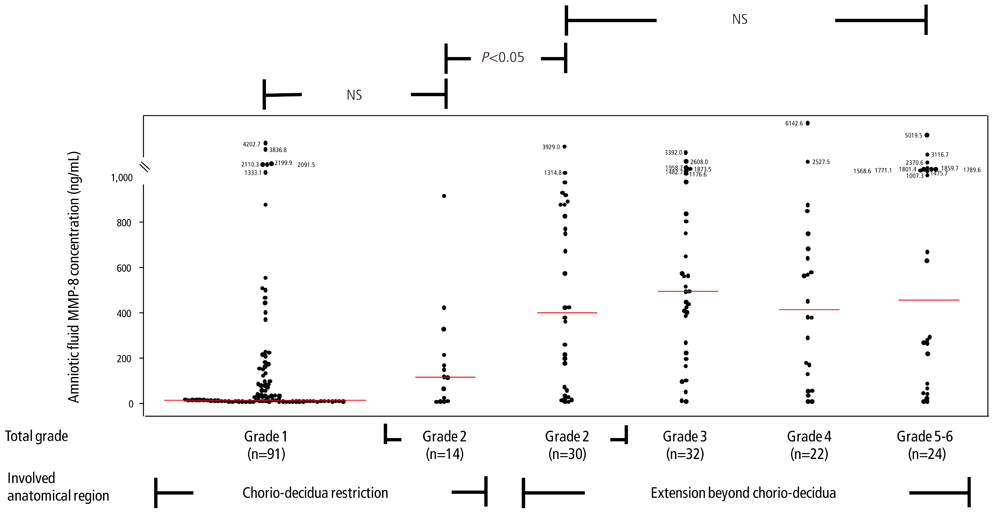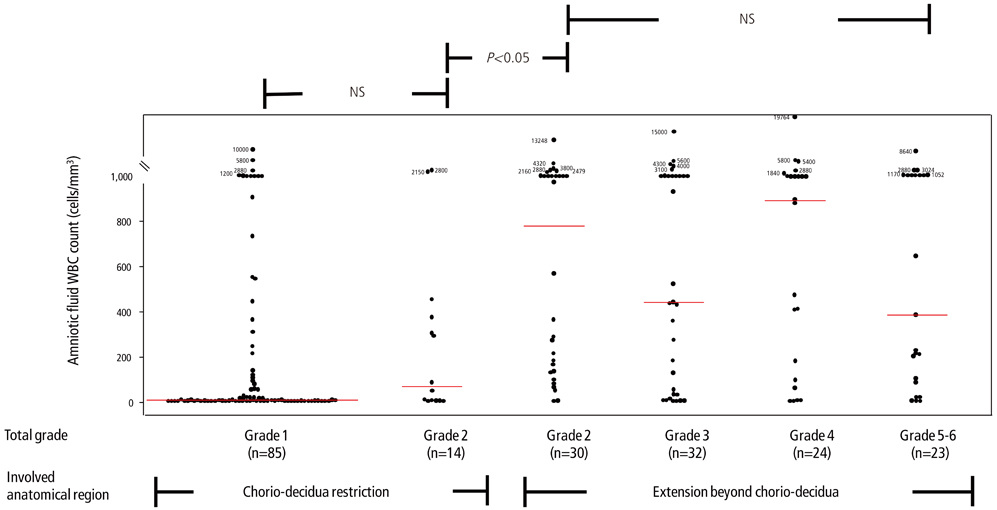Obstet Gynecol Sci.
2013 Jul;56(4):227-233.
Which is more important for the intensity of intra-amniotic inflammation between total grade or involved anatomical region in preterm gestations with acute histologic chorioamnionitis?
- Affiliations
-
- 1Department of Obstetrics and Gynecology, Seoul National University College of Medicine, Seoul, Korea. hwpark0803@gmail.com
Abstract
OBJECTIVE
There is no data on which is more important for the intensity of intra-amniotic inflammation (IAI) between total grade or involved anatomical region in acute histologic chorioamnionitis (acute-HCA) of preterm-gestations. The objective of current study is to examine this issue.
METHODS
The intensity of IAI was measured by amniotic fluid (AF) white blood cell (WBC) count and matrix metalloproteinase-8 (MMP-8) concentration in 225 singleton preterm-gestations (<36 weeks) who had acute-HCA including chorio-decidua involvement and delivered within 5 days of amniocentesis. Acute-HCA was defined in the presence of acute inflammatory changes in each anatomical region (i.e., chorio-decidua, amnion or chorionic plate). Patients were divided into 6 groups according to total grade (i.e., 1-6) and the presence or absence of chorio-decidua restriction (i.e., chorio-decidua restriction vs. extension beyond chorio-decidua) of acute-HCA.
RESULTS
There was no significant difference in a median AF WBC and MMP-8 between the two groups (group-1, cases with total grade 1 vs. group-2, cases with total grade 2) among cases with chorio-decidua restriction (each for P>0.05) and between the four groups (group-3, cases with total grade 2 vs. group-4, cases with total grade 3 vs. group-5, cases with total grade 4 vs. group-6, cases with total grade 5-6) among cases with extension beyond chorio-decidua (each for P>0.05). However, group-3 (cases with extension beyond chorio-decidua) had a significantly higher median AF WBC and MMP-8 than group-2 (cases with chorio-decidua restriction) among cases with total grade 2 (each for P<0.05).
CONCLUSION
Involved anatomical region is more important than total grade for the intensity of IAI in acute-HCA of preterm-gestations.
Keyword
MeSH Terms
Figure
Reference
-
1. Redline RW, Faye-Petersen O, Heller D, Qureshi F, Savell V, Vogler C, et al. Amniotic infection syndrome: nosology and reproducibility of placental reaction patterns. Pediatr Dev Pathol. 2003. 6:435–448.2. van Hoeven KH, Anyaegbunam A, Hochster H, Whitty JE, Distant J, Crawford C, et al. Clinical significance of increasing histologic severity of acute inflammation in the fetal membranes and umbilical cord. Pediatr Pathol Lab Med. 1996. 16:731–744.3. Keenan WJ, Steichen JJ, Mahmood K, Altshuler G. Placental pathology compared with clinical outcome: a retrospective blind review. Am J Dis Child. 1977. 131:1224–1227.4. Romero R, Salafia CM, Athanassiadis AP, Hanaoka S, Mazor M, Sepulveda W, et al. The relationship between acute inflammatory lesions of the preterm placenta and amniotic fluid microbiology. Am J Obstet Gynecol. 1992. 166:1382–1388.5. Park KH, Yoon BH, Choe G, Jun JK, Syn HC. The relationship between the presence, severity, and pattern of acute placental inflammation and amniotic fluid white blood cell count in preterm labor. Prenat Neonatal Med. 1997. 2:294–299.6. Halgunset J, Johnsen H, Kjollesdal AM, Qvigstad E, Espevik T, Austgulen R. Cytokine levels in amniotic fluid and inflammatory changes in the placenta from normal deliveries at term. Eur J Obstet Gynecol Reprod Biol. 1994. 56:153–160.7. Rogers BB, Alexander JM, Head J, McIntire D, Leveno KJ. Umbilical vein interleukin-6 levels correlate with the severity of placental inflammation and gestational age. Hum Pathol. 2002. 33:335–340.8. Park JS, Romero R, Yoon BH, Moon JB, Oh SY, Han SY, et al. The relationship between amniotic fluid matrix metalloproteinase-8 and funisitis. Am J Obstet Gynecol. 2001. 185:1156–1161.9. Yoon BH, Romero R, Shim JY, Shim SS, Kim CJ, Jun JK. C-reactive protein in umbilical cord blood: a simple and widely available clinical method to assess the risk of amniotic fluid infection and funisitis. J Matern Fetal Neonatal Med. 2003. 14:85–90.10. Yoon BH, Romero R, Park JS, Kim M, Oh SY, Kim CJ, et al. The relationship among inflammatory lesions of the umbilical cord (funisitis), umbilical cord plasma interleukin 6 concentration, amniotic fluid infection, and neonatal sepsis. Am J Obstet Gynecol. 2000. 183:1124–1129.11. Park CW, Moon KC, Park JS, Jun JK, Romero R, Yoon BH. The involvement of human amnion in histologic chorioamnionitis is an indicator that a fetal and an intra-amniotic inflammatory response is more likely and severe: implications. Placenta. 2009. 30:56–61.12. Park CW, Moon KC, Park JS, Jun JK, Yoon BH. The frequency and clinical significance of intra-uterine infection and inflammation in patients with placenta previa and preterm labor and intact membranes. Placenta. 2009. 30:613–618.13. Park CW, Kim SM, Yang HJ, Romero R, Yoon BH. Acute histologic choriodeciduitis is associated with an intra-amniotic inflammatory response, but not a maternal and fetal inflammatory response: implications of the staging of inflammation of the chorioamniotic membranes. Am J Obstet Gynecol. 2009. 201:S190.14. Yoon BH, Romero R, Kim CJ, Jun JK, Gomez R, Choi JH, et al. Amniotic fluid interleukin-6: a sensitive test for antenatal diagnosis of acute inflammatory lesions of preterm placenta and prediction of perinatal morbidity. Am J Obstet Gynecol. 1995. 172:960–970.15. Yoon BH, Yang SH, Jun JK, Park KH, Kim CJ, Romero R. Maternal blood C-reactive protein, white blood cell count, and temperature in preterm labor: a comparison with amniotic fluid white blood cell count. Obstet Gynecol. 1996. 87:231–237.16. Yoon BH, Jun JK, Park KH, Syn HC, Gomez R, Romero R. Serum C-reactive protein, white blood cell count, and amniotic fluid white blood cell count in women with preterm premature rupture of membranes. Obstet Gynecol. 1996. 88:1034–1040.17. Yoon BH, Romero R, Park JS, Kim CJ, Kim SH, Choi JH, et al. Fetal exposure to an intra-amniotic inflammation and the development of cerebral palsy at the age of three years. Am J Obstet Gynecol. 2000. 182:675–681.18. Shim SS, Romero R, Hong JS, Park CW, Jun JK, Kim BI, et al. Clinical significance of intra-amniotic inflammation in patients with preterm premature rupture of membranes. Am J Obstet Gynecol. 2004. 191:1339–1345.
- Full Text Links
- Actions
-
Cited
- CITED
-
- Close
- Share
- Similar articles
-
- The relationship between the presence, severity and pattern of acute placental inflammation and amniotic fluid interleukin-8 in preterm labor
- The relationship between amniotic fluid white blood cell count and the presence and severity of acute placental inflammation in preterm premature rupture of membrane
- The Association with Amniotic Fluid Interleukin-6 and Histologic Chorioamnionitis in Patients with Preterm Labor and Intact Membranes
- The frequency and clinical significance of intra-amniotic inflammation defined as an elevated amniotic fluid matrix metalloproteinase-8 in patients with preterm labor and low amniotic fluid white blood cell counts
- A comparative study of the diagnostic value of amniotic fluid interleukin-6 and culture for the antenatal diagnosis of intrauterine infection and prediction of perinatal morbidity in patients with preterm premature rupture of membranes



